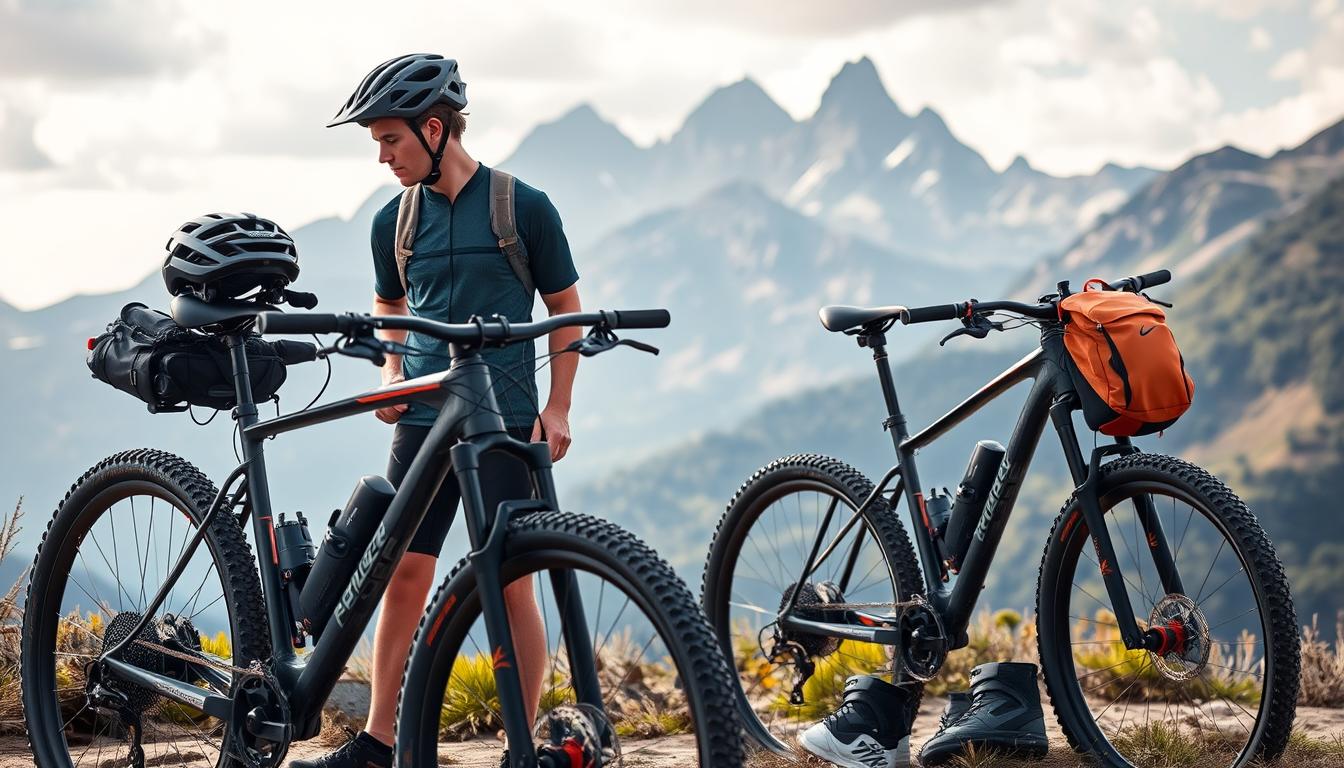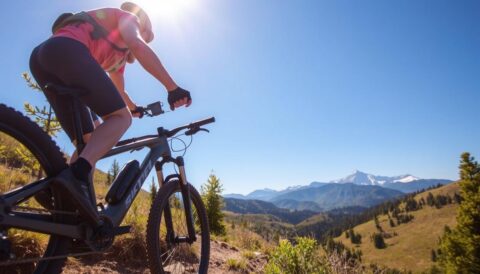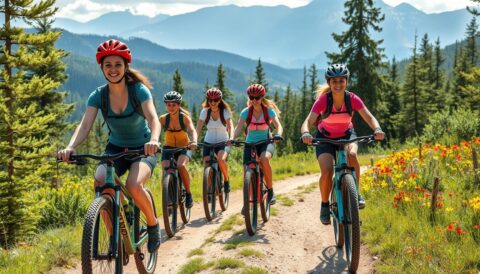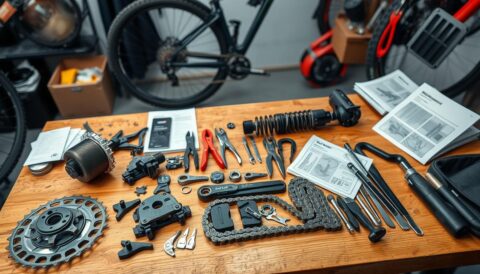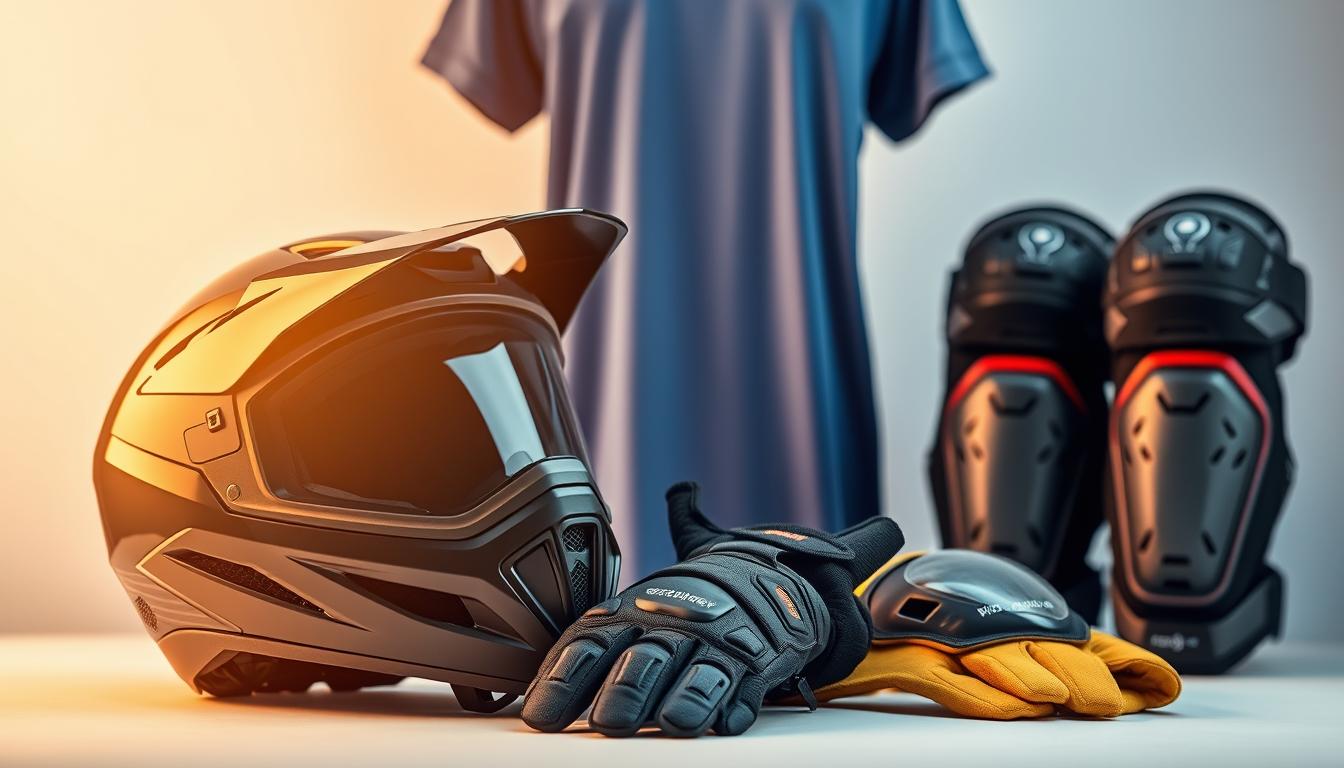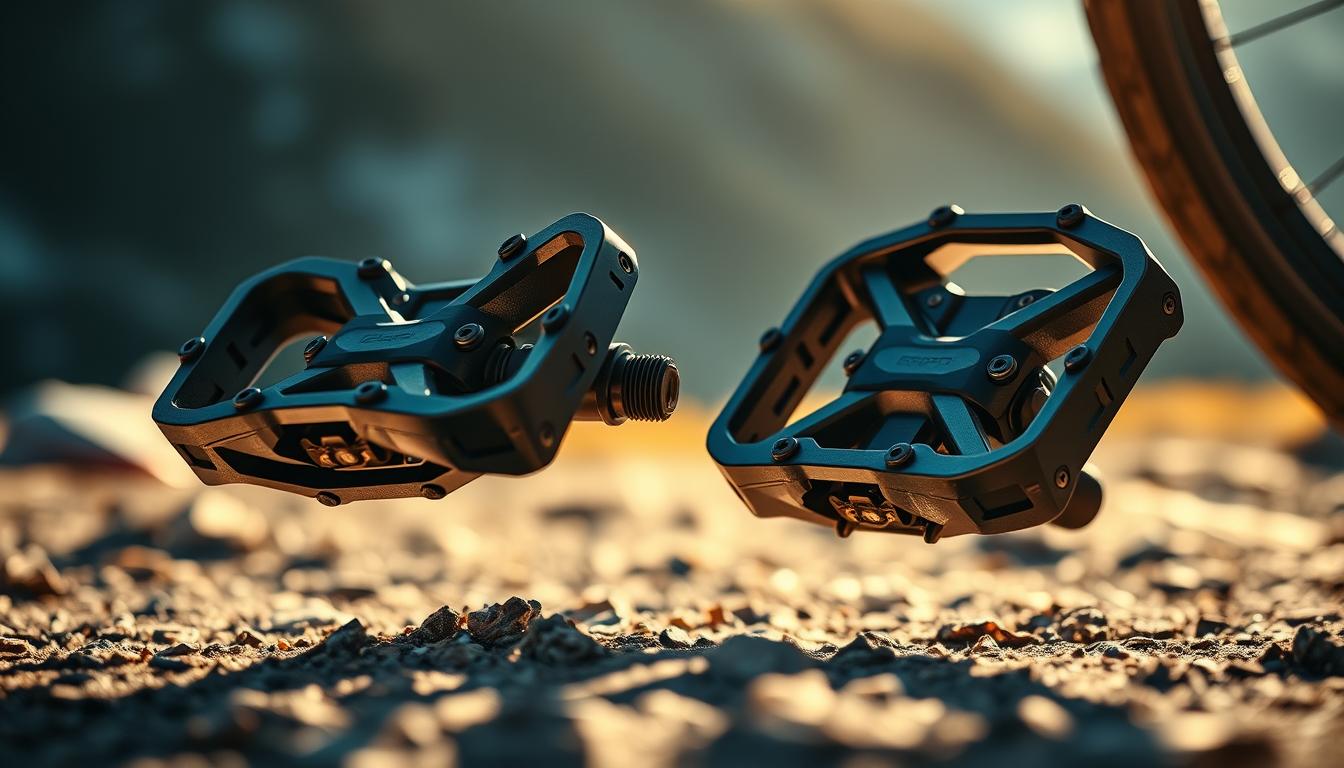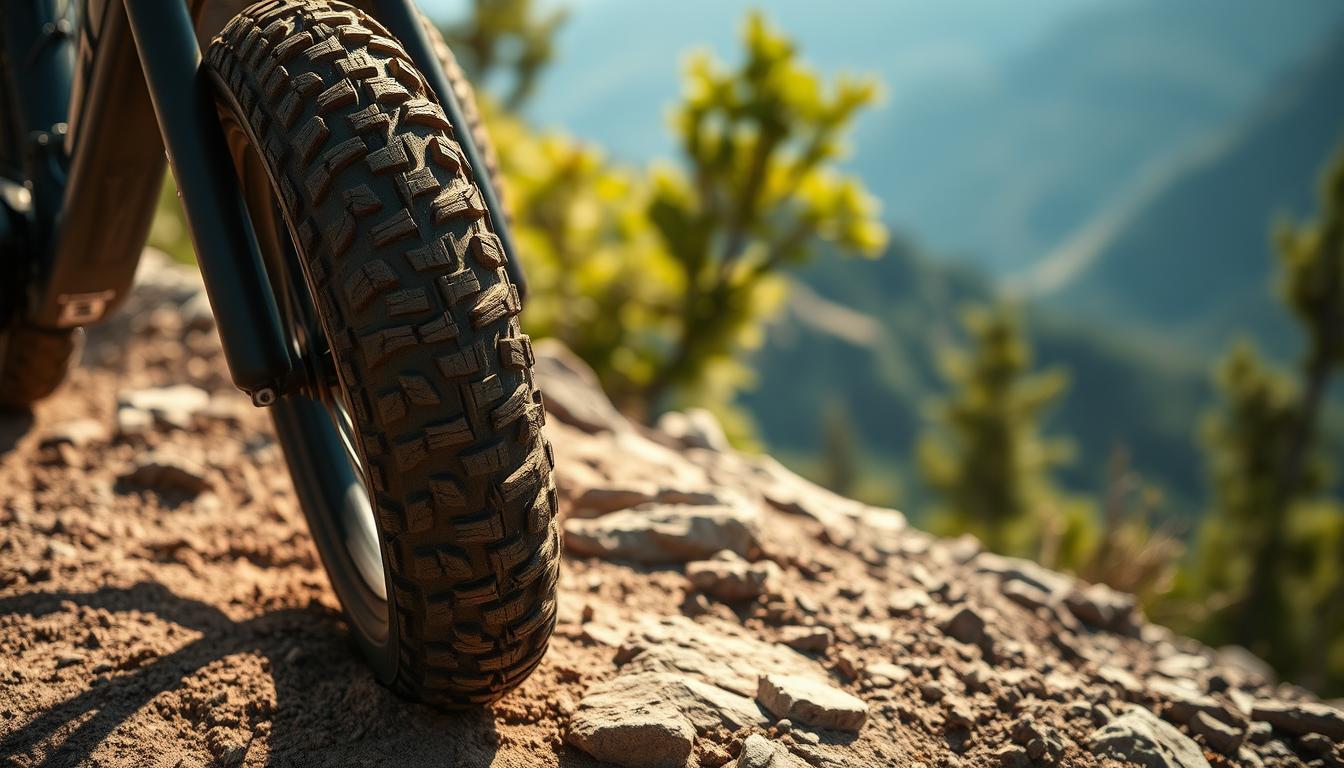When you set off for a mountain biking adventure, the right gear can make all the difference. Whether you’re tackling tough trails or enjoying a leisurely ride, comfort and practicality are key to a enjoyable experience. This guide will help you discover the gear essentials for your next off-road adventure, ensuring you stay safe, comfortable, and stylish throughout your journey.
Mountain biking is all about combining style with performance. The right outfit not only enhances your ride but also protects you from the elements and rough terrain. From moisture-wicking fabrics to durable materials, we’ll cover it all. This comprehensive buyer’s guide is designed specifically for riders in the UK, offering expert advice on what to wear for those extended excursions.
Long-sleeve jerseys, for instance, provide extended coverage, beneficial for protection against branches, rocks, and rough terrain during mountain biking1. They also feature a baggy fit, allowing for freedom of movement, which is crucial for navigating tight corners and technical descents1. Many long-sleeve jerseys are designed with ventilation panels, which significantly improve airflow and help regulate body temperature during climbs or intense riding1.
Stay tuned as we explore detailed sections about e-MTB clothing, accessories, and maintenance tips. Let’s dive into the world of mountain biking and uncover everything you need to know to make your next ride unforgettable.
Introduction to Long E-Mountain Biking Attire
Mountain biking requires careful selection of gear to ensure both comfort and safety. The right attire can significantly enhance your riding experience, whether you’re navigating challenging trails or enjoying a leisurely ride.
When it comes to mountain bike adventures, your clothes should be chosen to adapt to varying terrains and unpredictable weather conditions. A comprehensive selection of gear, including shorts, jerseys, gloves, and footwear, is essential for a safe and enjoyable ride2.
Safety is paramount, and the right protective gear can prevent injuries. For instance, knee pads are crucial for protecting against knee impact injuries, which are common in mountain biking2. Additionally, gloves provide both protection and grip, which is vital for maintaining control of your bike.
In the following sections, we will delve into each category of gear in detail, ensuring you are well-prepared for your next mountain biking adventure.
| Item | Features | Purpose |
|---|---|---|
| Jerseys | Moisture-wicking, breathable | Regulate body temperature |
| Shorts | Padded, durable | Comfort and protection |
| Gloves | Reinforced palms, grip | Control and safety |
| Footwear | Sturdy soles, secure fit | Support and traction |
By choosing the right gear, you can ensure a safe and enjoyable experience on your mountain bike adventures.
Understanding the Demands of E-MTB Adventures
E-MTB adventures present a mix of physical and environmental challenges that demand the right attire. Riders face tough terrain and extended ride durations, which can be physically demanding. Additionally, varying weather conditions and moisture levels affect both performance and comfort.
Protecting your body from the elements is crucial. Whether it’s rain or shine, your gear must withstand these conditions. Moisture-wicking fabrics help manage sweat, while waterproof materials keep you dry in wet weather3. The right clothing supports your body during high-impact rides, ensuring both protection and comfort.
Gearing up with durable, weather-resistant attire is essential. Riders need protection from rough terrain and weather conditions. Proper moisture management and ventilation are key to maintaining comfort during long rides. Selecting gear that can handle both sweat and rain ensures you stay comfortable and protected throughout your adventure.
In summary, E-MTB adventures require attire that offers durable protection, supports your body, and manages moisture effectively. The right gear helps you tackle trail challenges better and enjoy your ride more
Discovering the best E-MTB clothing for long rides
When preparing for an extended mountain biking adventure, selecting the right attire is crucial for both comfort and performance. This guide will help you navigate the process of choosing clothing that combines style, functionality, and durability, ensuring an enjoyable ride.
A well-chosen outfit can significantly enhance your mountain biking experience. Moisture-wicking fabrics, for instance, help manage sweat, keeping you cool and dry4. Padded shorts are another essential, reducing discomfort by up to 50% during long rides4. These items not only improve comfort but also boost your overall performance on the trail.
Specialist mountain bike clothing offers numerous performance benefits. Breathable jerseys with rear pockets are preferred by 70% of riders for their functionality4. Additionally, gloves with enhanced grip can improve handlebar control by 30%4, which is vital for navigating challenging trails. By investing in quality gear, you can ensure a safer and more enjoyable adventure.
Essential Apparel for Mountain Biking Safety and Comfort
Choosing the right apparel is vital for a safe and enjoyable mountain biking experience. The correct gear not only protects you from the elements and rough terrain but also enhances your performance and comfort on the trails.
Bike Shorts and Jerseys
Bike shorts are a cornerstone of mountain biking attire. They are designed with padding to reduce discomfort during long rides, offering up to 50% more comfort on extended sessions5. This padding, often found in the seat area, is crucial for maintaining comfort on bumpy trails. Additionally, the baggy design of these shorts provides excellent mobility, allowing riders to move freely without restriction. Jerseys, on the other hand, are crafted with moisture-wicking fabrics to keep you cool and dry. Many jerseys feature rear pockets, which are highly functional for storing small items like snacks, tools, or a map6.
Gloves and Footwear
Gloves are another essential component of mountain biking gear. They offer protection for your hands and improve grip on the handlebars, which is crucial for maintaining control, especially on technical terrain. Footwear is equally important, with options available to suit different riding styles. Clipless shoes provide excellent pedal efficiency and are preferred by many riders, while flat shoes offer better stability for those still building confidence on the bike5.
By investing in high-quality bike shorts, jerseys, gloves, and footwear, you can ensure a safe and comfortable mountain biking experience. These items work together to protect you from the rigors of the trail while keeping you comfortable throughout your ride.
Base Layers: The Foundation of Performance
A good base layer is the cornerstone of any effective cycling outfit. It plays a vital role in regulating body temperature and wicking sweat away from the skin, ensuring you stay comfortable throughout your ride7.
High-quality base layers are designed to keep you cool in the summer and warm in the winter. Materials like merino wool are particularly popular due to their excellent insulation properties and breathability7. They also offer natural odour resistance, which is a big plus on long adventures.
A proper base layer is essential for layering. It allows you to add or remove additional layers as the weather changes, ensuring you always feel comfortable. For example, the Smartwool Merino 150 Base Layer is a great choice, with its flatlock seams that reduce chafing during rides8.
Whether you’re tackling a challenging trail or a leisurely ride, a well-chosen base layer can make all the difference. It’s the first line of defence against the elements and the key to maintaining optimal performance.
Jerseys for Breathability and Storage Options
A well-designed jersey is more than just a piece of fabric; it’s a key component of your mountain biking gear that enhances both comfort and functionality. A good jersey keeps you cool and dry, making it a top choice for mountain bike enthusiasts9.
Modern jerseys are crafted with breathable fabrics that wick moisture away from the skin, ensuring you stay cool even during intense rides10. Many feature integrated storage solutions like rear pockets, perfect for carrying snacks, tools, or a map. This practical design element is favored by a significant percentage of mountain bikers who prioritize storage in their jerseys10.
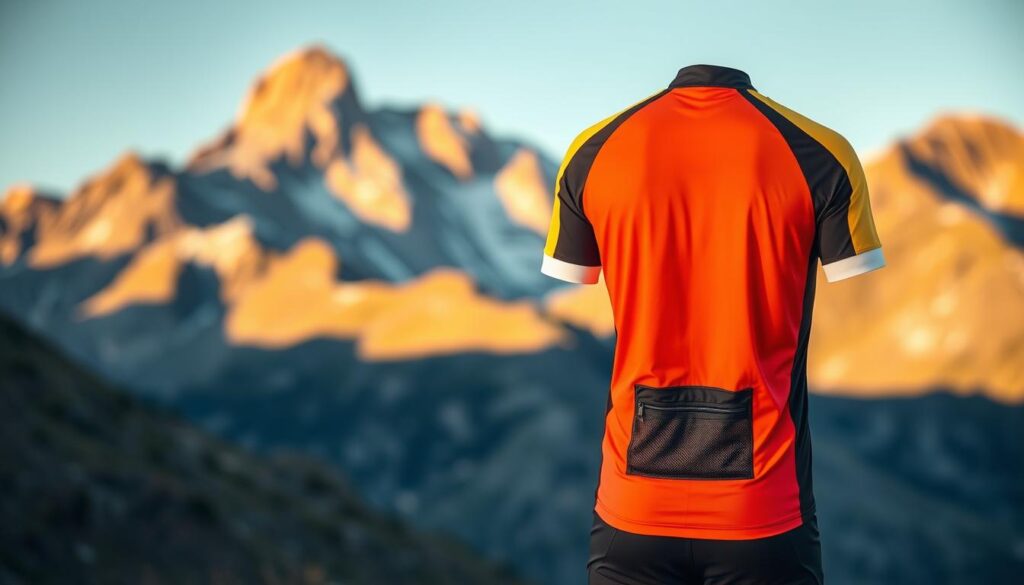
When comparing lightweight fabrics, it’s important to consider both comfort and durability. Jerseys made with TruDri® or Drirelease® technology are popular for their ability to remain comfortable over long rides while providing superior moisture management11. These materials not only enhance performance but also contribute to a more enjoyable riding experience.
Functional design innovations in jerseys can significantly boost overall performance. Features like mesh panels for improved ventilation and ergonomic fits ensure optimal comfort and mobility. Additionally, jerseys that complement layering strategies allow riders to adapt to changing weather conditions effortlessly11.
| Feature | Benefit | Example |
|---|---|---|
| Breathable Fabrics | Keeps you cool and dry | Moisture-wicking materials |
| Integrated Storage | Convenient access to essentials | Rear pockets |
| Lightweight Materials | Enhances comfort during long rides | TruDri® technology |
By investing in a high-quality jersey with these features, you can ensure a more comfortable and enjoyable mountain biking experience. Whether you’re tackling tough trails or enjoying a leisurely ride, the right jersey makes all the difference. For a wide selection of functional and stylish jerseys, visit Fox Racing to explore their range of performance-driven options.
Protective Gear: Helmets, Gloves and More
Protective gear is essential for any mountain biking adventure, ensuring your safety and confidence on the trails. A helmet is the most critical piece of protection, as it safeguards your head from impacts. Modern helmets often feature MIPS technology, which enhances safety by reducing rotational forces during a crash12.
Helmets for Optimal Safety
When choosing a helmet, consider models like the Giro Fixture MIPS or POC Tectal Race Spin, which offer superior protection and comfort. These helmets are designed to absorb impacts and provide ventilation, keeping you cool during intense rides. Full-face helmets are ideal for downhill and technical terrains, offering maximum protection for high-speed falls13.
Additional Protective Accessories
Gloves are another vital accessory, providing grip and protecting your hands. Look for full-finger gloves that offer heightened protection, especially for technical trails. Goggles are also recommended to shield your eyes from debris. For comprehensive safety, consider knee pads and back protectors, particularly for challenging rides13.
Investing in quality protective gear ensures a safer and more enjoyable experience. Always opt for gear that meets safety standards and suits your riding style.
Layering Strategies for Variable Weather Conditions
When heading out on a mountain biking adventure, the key to staying comfortable lies in mastering the art of layering. This approach allows you to adapt seamlessly to changing weather conditions, ensuring you remain cool, dry, and protected throughout your ride.
Adjusting Layers for Cold and Wet Days
Effective layering is all about combining base, mid, and outer layers to manage moisture and regulate body temperature. Here’s how you can adjust your layers based on the weather:
- Base Layer: Opt for moisture-wicking fabrics like merino wool or synthetic materials to keep your skin dry and comfortable14.
- Mid Layer: Add a breathable insulating layer, such as a fleece jacket, to trap warm air without restricting movement.
- Outer Layer: Use a waterproof and breathable jacket to protect against rain and wind while allowing moisture to escape14.
Remember, layering isn’t just about piling on clothes. It’s about creating a system that allows you to adjust as conditions change. For example, on a cold, wet day, start with a snug base layer, add a mid-layer for warmth, and finish with a waterproof shell. As you warm up, you can easily remove layers to stay comfortable15.
By mastering these layering strategies, you can tackle any weather condition with confidence. Whether it’s a chilly morning or a rainy afternoon, the right layers will keep you performing at your best.
Seasonal E-MTB Clothing: Adapting to the British Climate
The British climate is famously unpredictable, making it essential to adapt your cycling wardrobe to the changing seasons. Whether you’re braving the cold or enjoying the warmth, your clothing choice plays a crucial role in comfort and performance.
During warmer weather, opt for lightweight and breathable fabrics that wick moisture away from the skin, keeping you cool and dry16. These materials are designed to enhance airflow, ensuring you stay comfortable even on intense rides. In contrast, cold or wet conditions call for insulated and water-resistant materials to keep you warm and dry16.
Innovative design elements, such as adjustable cuffs and breathable panels, ensure your gear performs well under varying weather conditions. Technologies like TruDri® and Drirelease® are popular for their moisture-wicking properties, while materials with DWR coatings offer reliable water resistance17.
| Season | Fabric Type | Key Features |
|---|---|---|
| Summer | Moisture-wicking | Breathable, lightweight |
| Winter | Insulated, water-resistant | Warmth, durability |
Selecting gear that marries function with the British climate ensures a safe and enjoyable ride, no matter the season.
Material Matters: Merino Wool, Synthetic and More
When it comes to choosing the right fabrics for your mountain biking adventures, the debate often centres on natural versus synthetic materials. Both Merino wool and synthetic fabrics have their unique advantages, catering to different riding conditions and preferences.
Merino wool stands out for its excellent insulation, breathability, and natural odour resistance, making it a favourite for cold-weather rides18. It can absorb up to 35% of its weight in water before feeling damp, ensuring you stay dry and comfortable19. Synthetic fabrics, on the other hand, excel in moisture-wicking and drying quickly, which is ideal for high-intensity activities18.
While Merino wool offers superior warmth and odour control, it is generally more expensive and requires extra care18. Synthetic fabrics are more durable and less prone to snags, making them a practical choice for rugged trails19. Products like the Smartwool Merino 150 Base Layer exemplify the benefits of Merino wool, while synthetic options from brands like Rab offer excellent durability and moisture management.
| Material | Insulation | Breathability | Moisture-Wicking | Odour Resistance | Cost |
|---|---|---|---|---|---|
| Merino Wool | Excellent | High | Good | Natural | Higher |
| Synthetic | Good | Fair | Excellent | Variable | Lower |
Innovations in fabric technology have led to blended materials, such as corespun yarns, which combine the best of both worlds. These blends offer enhanced durability while maintaining the natural benefits of Merino wool19. Whether you prefer the natural warmth of Merino wool or the durability of synthetic fabrics, the right choice will enhance your mountain biking experience.
Achieving the Ideal Fit for Maximum Mobility
Achieving the perfect fit in cycling apparel is essential for a comfortable and effective ride. The right fit ensures unrestricted movement, allowing you to perform at your best on the trails. As noted, “Having the proper fit is crucial when it comes to mountain biking since it influences how you ride on the trails”20.
Design features such as Velcro cuffs, elastic waistbands, and adjustable hemlines play a significant role in achieving a great fit. These elements contribute to a snug yet comfortable design, allowing for optimal body movement. For instance, adjustable cuffs can be tailored to your preference, ensuring a secure fit without restricting circulation20.
The right fit also helps prevent chafing and allows for optimal body movement. A snug fit enhances performance by reducing fabric friction, while a slightly looser fit ensures comfort during long rides. This balance is key to enjoying your mountain biking experience without discomfort or restriction20.
Examples of products engineered for precision fit and innovative design include the Endura MT500 range, known for its ergonomic design and adjustable features. These products exemplify how the right fit can enhance mobility and overall performance on the trails20.
Essential Accessories to Enhance Your Ride
Accessories play a vital role in enhancing both the safety and enjoyment of your mountain biking adventures. Whether you’re a seasoned cyclist or just starting out, having the right gear can make a significant difference.
Functional accessories like hydration packs and GPS cycle computers are must-haves for any serious mountain biker. A hydration pack ensures you stay hydrated throughout your ride, which is especially important as riders should carry at least 2 litres of water for rides lasting over 2 hours21. GPS devices, on the other hand, provide real-time navigation and performance tracking, improving accuracy by up to 90% in remote areas with no mobile signal21.
Small but crucial items like repair kits and secure pedals can greatly impact ride safety and efficiency. A puncture repair kit is essential as it prevents interruptions caused by punctures, which can halt your ride immediately21. Additionally, pedals like the Crankbrothers Mallet Trail Pedals are designed for aggressive riding, enhancing grip and control on technical trails22.
Integrating these accessories with your existing gear can significantly improve performance. For instance, a multi-tool can address up to 10 different mechanical issues, increasing the likelihood of resolving minor problems on the trail21. Products like the Fix Mfg MTB Field Kit exemplify how essential tools can be for trail-side repairs22.
By investing in these accessories, you can ensure a safer and more efficient ride. Whether it’s a hydration pack, GPS device, or repair kit, each item contributes to a more enjoyable mountain biking experience.
Maintenance and Care Tips for MTB Clothing
Properly maintaining your mountain biking apparel is essential to extend its life and performance. Regular care not only preserves the protective qualities of your gear but also ensures it remains comfortable and functional for years to come.
Cleaning Techniques
Cleaning your gear to remove dirt, sweat, and bacteria is crucial for maintaining the integrity of mountain biking apparel23. Use gentle detergents specifically formulated for sports attire to avoid damaging the fabrics. Avoid harsh chemicals like bleach or fabric softeners, as they can degrade the material and harm its moisture-wicking properties24.
Washing machines from the last decade are designed with load-sensing technology, which can reduce water usage compared to hand-washing24. However, high water temperatures can irreparably damage garments, particularly affecting the elastic and wicking capabilities of fabrics24. Detergent usage is often overestimated; only a small amount is necessary due to the concentration of modern detergents24.
Storage Best Practices
Air drying and proper storage are key to extending the life of your clothing. Hang dry next-to-skin garments to prevent heat damage from dryers, which can bake in odors and oils25. Store your gear in a cool, dry place to prevent moisture buildup and bacterial growth.
Fabric softeners are discouraged as they can leave residues that trap oils and odors, potentially damaging the elastane in synthetic fabrics24. An extra rinse cycle can ensure that detergent is fully rinsed out, promoting garment longevity24.
| Practice | Details | Benefit |
|---|---|---|
| Gentle Detergents | Use sports-specific detergents | Preserves fabric integrity |
| Air Drying | Avoid dryers; hang to dry | Prevents heat damage |
| Proper Storage | Store in cool, dry areas | Prevents moisture buildup |
By following these maintenance tips, you can ensure your mountain biking apparel remains in great condition, providing protection and comfort for many adventures to come.
Integrating Style with Function on the Trail
Mountain biking apparel has evolved to seamlessly merge aesthetic appeal with technical innovation. Modern riders no longer have to choose between looking good and performing well, as today’s designs offer the perfect blend of style and functionality. This section explores how current fashion trends and functional design innovations are reshaping the world of mountain biking attire.
Current Fashion Trends
Current fashion trends in mountain biking are all about bold colours and dynamic patterns. Many riders prefer vibrant designs that make a statement on the trails. Brands like Fox Racing and POC have embraced this trend, offering a wide range of stylish options that cater to different preferences26. Additionally, there’s a growing emphasis on utility-focused silhouettes, with functional details like pockets and adjustable features becoming integral to modern designs.
Functional Design Innovations
Functional design innovations are at the heart of modern mountain biking apparel. Features like breathable fabrics, moisture-wicking materials, and integrated storage solutions enhance both performance and visual appeal. For instance, jerseys with rear pockets not only provide a practical way to carry essentials but also add to the overall design aesthetic27. Similarly, padded shorts with sleek designs offer comfort without compromising on style.
Brands such as Endura and Troy Lee Designs exemplify this balance between fashion and function. Their collections often feature vibrant colours, innovative patterns, and cutting-edge materials that cater to the demands of both performance and style-conscious riders26. By integrating these elements, modern mountain biking apparel ensures that riders can enjoy a seamless combination of form and function on the trails.
Ultimately, the integration of style and function in mountain biking apparel reflects the evolving needs of modern riders. Whether it’s through bold designs or innovative features, today’s options offer the perfect blend of aesthetic appeal and technical performance.
Advanced Features in E-MTB Gear Design
Modern e-MTB gear has seen significant advancements, integrating innovative technologies that elevate both performance and safety. These cutting-edge features are designed to meet the evolving needs of cyclists, ensuring a more enjoyable and efficient riding experience.
One notable innovation is the use of enhanced ventilation systems, which improve airflow and help regulate body temperature during intense rides28. Additionally, secure closures and impact-absorbing materials have become standard, providing superior protection without compromising comfort. These advancements not only enhance safety but also boost overall cycling performance.
Real-world examples of these innovations include MIPS technology in helmets, which reduces rotational forces during impacts, and ergonomic designs in gloves that improve grip and control29. Such features are integral to modern gear design, keeping pace with the latest cycling technologies. For instance, the Santa Cruz Vala showcases how advanced features can seamlessly integrate into e-MTB design, offering a top-tier cycling experience.
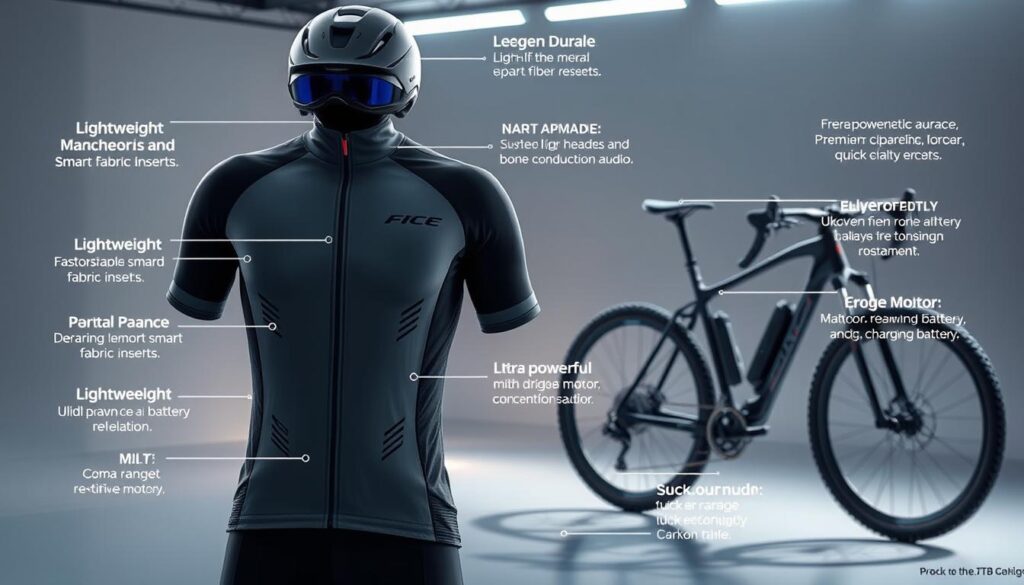
As e-MTB technology continues to evolve, so too does the gear that supports it. These continuous advancements ensure that cyclists have access to the latest innovations, making every ride safer, more comfortable, and more enjoyable.
Conclusion
As you embark on your next mountain biking adventure, remember that the right gear is your gateway to a safer and more enjoyable experience. Whether you’re cruising through rolling hills or tackling rugged trails, prioritising safety, comfort, and durability in your apparel ensures you’re prepared for any challenge.
A well-planned layering system is essential for adapting to changing conditions. Pair a moisture-wicking base layer with a breathable mid-layer and a waterproof outer shell to stay comfortable in unpredictable British weather30. Attention to fit and material quality also plays a crucial role in enhancing mobility and performance.
Incorporating advanced features like reinforced padding, secure closures, and impact-absorbing materials can elevate your riding experience. Accessories such as hydration packs, GPS devices, and puncture repair kits are also vital for efficiency and safety on the road30.
Use this guide to make informed decisions when selecting your gear. For further insights into optimising your e-bike setup, visit our comprehensive guide here. Happy trails!
FAQ
What are the essential items to wear for a long E-Mountain biking ride?
The essential items include a helmet, bike shorts, a breathable jersey, gloves, sturdy footwear, and protective gear like knee pads. These ensure both safety and comfort during your adventure.
How should I dress for different weather conditions?
Always check the weather forecast. Wear waterproof and breathable layers for rain, and use lightweight, moisture-wicking fabrics for dry conditions. Adjust your clothing as needed during the ride.
Why is a helmet crucial for E-Mountain biking?
A helmet is vital for protecting your head from impacts. Look for one with good ventilation and a secure fit to ensure safety without compromising comfort.
What are the benefits of layering clothing?
Layering helps regulate body temperature. A merino wool base layer keeps you cool in summer and warm in winter, while an outer jacket provides wind and rain protection.
Which fabric is best for cycling jerseys?
Opt for breathable, moisture-wicking fabrics like merino wool or synthetic materials. These keep you dry and comfortable, regardless of the intensity of your ride.
How important is the fit of cycling gear?
A proper fit is crucial for mobility and comfort. Ensure your gear isn’t too tight or restrictive, allowing for a full range of motion while riding.
How can I stay hydrated during long rides?
Use a hydration pack or water bottles on your bike. Plan your route to include stops where you can refill your water supply.
Why are gloves necessary for cycling?
Gloves provide grip, protect your hands from blisters, and cushion vibrations. They are essential for maintaining control and comfort during long rides.
How should I maintain my cycling gear?
Regularly wash your gear with mild detergent, avoiding fabric softeners. Store items in a cool, dry place to prevent damage and extend their lifespan.
Source Links
- The Best Long-Sleeve Mountain Bike Jerseys
- What e-MTB Protective Gear to Wear in 2023 – E Mountain Bikes
- Advertorial: How to choose your eMTB outfit
- Essential MTB Clothing: What to Wear on the Trail
- What to wear mountain biking
- What e-MTB Protective Gear to Wear in 2023 – E Mountain Bikes
- Essentials: Cold Weather Mountain Biking Gear
- The Review | ODLO EVOLUTION WARM Baselayer Test
- Mountain Bike Jerseys | Fox Racing® UK
- Essential MTB Clothing: What to Wear on the Trail
- Best cycling jerseys ridden and rated
- The eMTB protection guide – How much protection should I wear whilst riding my eMTB?
- What e-MTB Protective Gear to Wear in 2023 – E Mountain Bikes
- How to Layer for Cycling
- What to Wear in Various Weather
- Best mountain bike trousers reviewed and rated by experts – MBR
- Best mountain bike pants 2025: rated and reviewed by our experts
- Gear Wars: Merino Wool vs. Synthetic Base Layers – The Trek
- Choosing the Best Base Layer – Merino wool vs Synthetic fibres
- Are DIY bike fits any good? How to set yourself up for comfort on the bike
- Essential eMTB Gear for Every Ride (2023) – E Mountain Bikes
- Top 10 Must-Have MTB Accessories and Products for Every Mountain Biker
- What clothing to wear on a bike ride
- How to Wash Your Kit, According to the People Who Made It
- Cycling clothing guide
- Essential MTB Clothing: What to Wear on the Trail
- What to Wear Mountain Biking
- NSMB.com – Rossignol Mandate Shift XT E-MTB Longterm Review
- The best e-mountainbike of 2023 – The biggest group test yet: 30 e-mountainbikes head-to-head
- What Kind of Clothes Do You Need to Wear When Riding an Electric Bicycle
